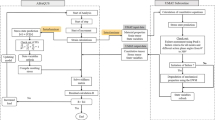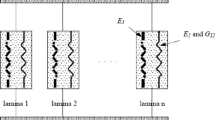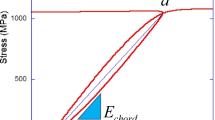Abstract
There have been several approaches used in the modelling of the process-induced deformations of composite parts developed so far. The most universal and most frequently used approach is the FEM modelling. In the scope of the FEM modelling several material models have been used to model the composite behaviour. In the present work two of the most popular material models: elastic and CHILE (cure hardening instantaneous linear elastic) are used to model the spring-in deformations of composite specimens and a structure fragment. The elastic model is more effective, whereas the CHILE model is considered more accurate. The results of the models are compared with each other and with the measured deformations of the real composite parts. Such a comparison shows that both models allow to predict the deformations reasonably well and that there is little difference between their results. This leads to a conclusion that the use of the simpler elastic model is a valid engineering practice.







Similar content being viewed by others
References
Albert C., Fernlund G.: Spring-in and warpage of angled composite laminates. Compos. Sci. Technol. 62, 1895–1912 (2002)
Radford D.W., Rennick T.S.: Separating sources of manufacturing distortion in laminated composites. J. Reinf. Plast. Comp. 19, 621–641 (2000)
Wisnom M.R., Potter K.D.: Understanding composite distortion during processing. In: Long A.C. (ed.) Composites Forming Technologies, pp. 177–196. Woodhead Publishing Limited, Cambridge (2007)
Zobeiry, N., Viscoelastic constitutive models for evaluation of residual stresses in thermoset composites during cure. PhD Thesis, University of British Columbia (2006)
Radford D.W., Diefendorf R.J.: Shape instabilities in composites resulting from laminate anisotropy. J. Reinf. Plast. Comp. 12, 58–75 (1993)
Svanberg J.M., Holmberg J.A.: An experimental investigation on mechanisms for manufacturing induced shape distortions in homogeneous and balanced laminates. Compos. Part A – Appl S. 32, 827–838 (2001)
Ersoy, N., Garstka, T., Potter, K., Wisnom, M.R., Porter, D., Stringer, G.: Modelling of the spring-in phenomenon in curved parts made of a thermosetting composite. Compos. Part A – Appl S. 41, 410–418 (2010)
Dong, C.: A parametric study on the process-induced deformation of composite T-stiffener structures. Compos. Part A – Appl S. 41, 515–520 (2010)
Dong C.: Process-induced deformation of composite T-stiffener structures. Compos. Struct. 92, 1614–1619 (2010)
Bapanapalli S.K., Smith L.V.: A linear finite element model to predict processing-induced distortion in FRP laminates. Compos. Part A – Appl S. 36, 1666–1674 (2005)
Wucher B., Lani F., Pardoen T., Bailly C., Martiny P.: Tooling geometry for compensation of cure-induced distortions of a curved carbon/epoxy C-spar. Compos. Part A – Appl S. 56, 27–35 (2014)
Kappel, E., Stefaniak, D., Huhne, C.: Semi-analytical spring-in analysis to counteract CFRP manufacturing deformations by tool compensation. In: Proceedings of 28th ICAS 2012 Conference Brisbane, Paper 126 (2012)
Fernlund G., Rahman N., Courdji R., Bresslauer M., Poursartip A., Willden K., Nelson K.: Experimental and numerical study of the effect of cure cycle, tool surface, geometry and lay-up on the dimensional fidelity of autoclave-processed composite parts. Compos. Part A – Appl S. 33, 341–351 (2002)
Fernlund, G., Poursartip, A.: The effect of tooling material, cure cycle and tool surface on spring-in of autoclave processed curved composite parts. In: Proceedings of ICCM - 12 Conference Paris, Paper 690 (1999)
Fernlund G., Osooly A., Poursartip A., Vaziri R., Courdji R., Nelson K., George P., Hendrickson L., Griffith J.: Finite element based prediction of process-induced deformation of autoclaved composite structures using 2D process analysis and 3D structural analysis. Compos. Struct. 62, 223–234 (2003)
Osmęda A.: Measurements of strain induced by chemical shrinkage in polymer composites. J. Polym. Eng. 36, 431–440 (2016)
Holmberg J.A.: Influence of chemical shrinkage on shape distortion of RTM composites. In: Proceedings of 19th SAMPE Conference Paris. 621–632 (1998)
Shimbo M., Ochi M., Shigeta Y.: Shrinkage and internal stresses during curing of epoxide resin. J. Appl. Polym. Sci. 26, 2265–2277 (1981)
Madhukar M.S., Genidy M.S., Russell J.D.: A new method to reduce cure-induced stresses in thermoset polymer composites. Part I: Test method. J. Compos. Mater. 34, 1882–1904 (2000)
Garstka T., Ersoy N., Potter K.D., Wisnom M.R.: In situ measurements of through-the-thickness strains during processing of AS4/8552 composite. Compos. Part A – Appl S. 38, 2517–2526 (2007)
Ersoy N., Tugutlu M.: Cure kinetics modeling and cure shrinkage behawior of a thermosetting composite. Polym. Eng. Sci. 50, 84–92 (2010)
Wisnom M.R., Potter K.D., Ersoy N.: Shear-lag analysis of the effect of thickness on spring-in of curved composites. J. Compos. Mater. 41, 1311–1324 (2007)
Acknowledgments
This research was carried out in the scope of Institute of Aviation statutory activity: ‘Manufacturing study of tail rotor blades and main rotor blades. Design and manufacturing of technologically advanced blades for ILX rotorcraft. Verification of tail rotor blade design technology.’
Author information
Authors and Affiliations
Corresponding author
Rights and permissions
About this article
Cite this article
Galińska, A. Material Models Used to Predict Spring-in of Composite Elements: a Comparative Study. Appl Compos Mater 24, 159–170 (2017). https://doi.org/10.1007/s10443-016-9519-y
Received:
Accepted:
Published:
Issue Date:
DOI: https://doi.org/10.1007/s10443-016-9519-y




